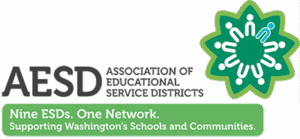A small investment by the state produces huge dividends for education.
Return on Investment
ESDs provide equity for all students, in all districts.
After more than 50 years of service to schools in six Southwest Washington counties, ESD 112 remains focused on quality service. Together with the urban and rural districts we serve, we are able to leverage a small amount of state funding to build effective, cost efficient and innovative programs that help districts save money and leverage resources.
Washington’s ESDs are increasingly depended upon to provide essential services for school districts and communities, to help OSPI implement legislative education initiatives. Smaller districts often have fewer resources and rely heavily on ESDs to help provide essential services. However, the state’s larger school districts also take advantage of ESDs for cost efficiency, resource sharing, technical assistance and program implementation.
Here are just a few ways that we work with our districts:
ESD 112 Financial Snapshot
Core Funding
While ESD 112 is an essential part of state and regional education services, annual state funding for basic operational expenses is minimal. Of ESD 112’s $103 million budget, only 1% is directly appropriated by the state. The ESD uses that seed money to secure collaborative grants, manage fee-for-service partnerships and operate resourceful cooperatives and trusts. In fact, for every $1 invested in core funding, the ESD provides nearly $100 in services! That’s a remarkable return on the state’s investment.
ESD 112 Budget by Source
for fiscal year ending August, 31, 2023
Legend—Funding Source Terms
- State / Agency Contracts – 53%
- OSPI / other state agency contracts for school district services (i.e. nursing corps, transportation, special education, early childhood services, etc.)
- Payments for Cooperative Programs – 11%
- School districts “pooled” funds for services (i.e. data management, special education, risk, science materials, insurance, etc.)
- Federal Sources – 16%
- Competitively gained contracts/grants (i.e. Head Start, youth employment, special education, school improvement, etc.)
- Payments for Other Programs – 17%
- Local districts / other governmental contracts / foundation grants for specific education services (i.e. speech, hearing, construction, etc.) / other philanthropic awards
- Local Sources – 2%
- Workshop and certification fees, contracts to perform specific work for local entities
- Core Funding/Annually Legislated Appropriation – 1%
- Purpose is to fund regional support structure of nine Educational Service Districts to perform statutorily / legislatively mandated services and programs; to support 295 school districts’ in sharing funding to reduce costs; and to generate additional revenue for districts.
Statewide ESD Network Financial Snapshot
Nine ESDs. One Network.
As one in a network of nine ESDs located geographically throughout the state, we provide state mandated services such as fiscal grant management, special education and transportation, personnel services such as certification and fingerprinting, curriculum services, inservice training and assessment, budget reviews, programs for juveniles, school boundary reviews (resolution of disputes), professional conduct investigations and a variety of other statutory obligations. In addition to these state-mandated services, we bring millions of additional dollars to our state’s education system through cooperatives, trusts and federal, state and private grants.
Washington ESDs Core Funding Return on Investment
ESDs actually subsidize state-mandated programs by generating funds to deliver innovative services in early childhood education, curriculum/instruction improvement, technology, special education, insurance pools/ trusts, math, science and literacy support, school construction, substance abuse prevention, drop-out programs, emergency communications and personnel cooperatives.
Legend—Funding Source Terms
- Federal Sources
- Competitively gained contracts/grants (i.e. Head Start, youth employment, special education, school improvement, etc.)
- State / Agency Contracts
- OSPI / other state agency contracts for school district services (i.e. nursing corps, transportation, special education, early childhood services, etc.)
- Payments for Cooperative Programs
- School districts “pooled” funds for services (i.e. data management, special education, risk, science materials, insurance, etc.)
- Payments for Other Programs
- Local districts / other governmental contracts / foundation grants for specific education services (i.e. speech, hearing, construction, etc.) / other philanthropic awards
- Local Sources
- Workshop and certification fees, contracts to perform specific work for local entities
- State Core Funding
- Purpose is to fund regional support structure of nine Educational Service Districts to perform statutorily / legislatively mandated services and programs; to support 295 school districts’ in sharing funding to reduce costs; and to generate additional revenue for districts.
Source: AESD Website









 ESD 112 equalizes educational opportunities for learning communities through innovative partnerships, responsive leadership, and exceptional programs.
ESD 112 equalizes educational opportunities for learning communities through innovative partnerships, responsive leadership, and exceptional programs.